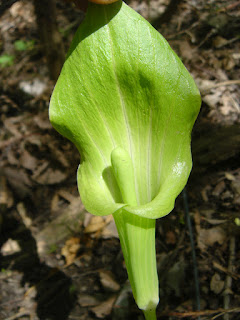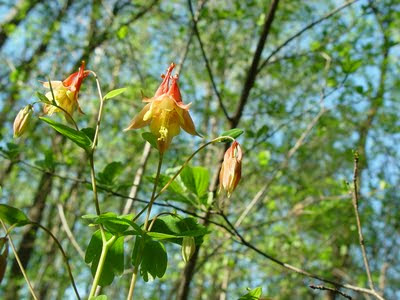The larch branches still bear cones from last year while this year's new cones open among them. The larch Larix laricina is also known as Tamarack . It's cones are approximately one inch tall, upright, initially rosey red and then turning brown. The cones fall in the second year and have a pair of brown long-winged seeds.
4/03/2012
4/01/2012
woodland flowers
The first Jack-in-the-Pulpit Arisaema triphyllum this season seems to be too green and bright; usually they are more secretive in shades of dark green and maroon. Maybe this one is a bit early, encouraged by the very warm winter?
3/24/2012
maple flowers
The maple trees are blooming. When the first blossoms on this variety Acer rubrum appear, they are golden; they become red in just a few days. Once the seeds form they remain red in extreme contrast to the leaves that open gold and become green.
3/16/2012
early springtime
2/25/2012
scant snow
1/19/2012
hunting hawk
12/27/2011
warm sun, cold day
11/05/2011
autumn beauties
The autumn colors on the maple tree make a beautiful backdrop for the peanut log, no matter the color of the birds feasting there.



8/09/2011
7/08/2011
mealworms for young Bluebirds
 The bluebirds bring their young fledglings to the mealworm plate. This is only a small part of the parents' efforts to teach their young how to hunt; another lesson is patience to sit on the hummingbird feeder poles scanning the grass below for insects. It usually pays off. We hope they're learning the territory, so they come back next year and nest again.
The bluebirds bring their young fledglings to the mealworm plate. This is only a small part of the parents' efforts to teach their young how to hunt; another lesson is patience to sit on the hummingbird feeder poles scanning the grass below for insects. It usually pays off. We hope they're learning the territory, so they come back next year and nest again.
7/07/2011
fledglings
6/12/2011
I noticed an unfamiliar growth on my rhubarb. Turns out, the rhubarb is BLOOMING. New to me, but evidently common on plants that have been in the ground a while, as mine have. They came from my Dad's back yard, and have been producing delicious stalks for five years. Obviously, something I will use as a subject to create some art. And the kids devised new ways to use the giant rhubarb leaves.
5/31/2011
feeding young Bluebirds


The video below shows the adult female Eastern Bluebird that flew into the nestbox with a worm dangling from her beak. She fed the worm to one of her four young birds, then turned up to the opening and accepted another worm from the adult male.
In this way they can feed all four of the hatchlings enough so they'll grow to nearly full size in two weeks.
5/30/2011
Eastern Bluebird hatchlings
5/23/2011
nesting House Wrens
nesting Eastern Bluebirds
feathered nest Tree Swallows
5/18/2011
Tree Swallows
Tree Swallows Tachycineta bicolor are building a nest in one of the nestboxes. They have been constructing the cup with grass and pine needles for a few days. Today, the female is adding feathers for the cup lining.
5/17/2011
Goldfinches
5/13/2011
young fledgling
5/12/2011
5/10/2011
Jack blooms in the woods
5/08/2011
Subscribe to:
Comments (Atom)























